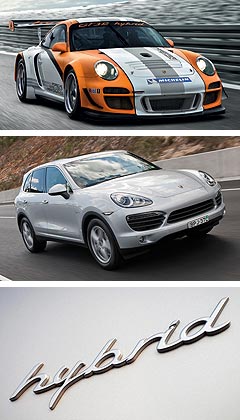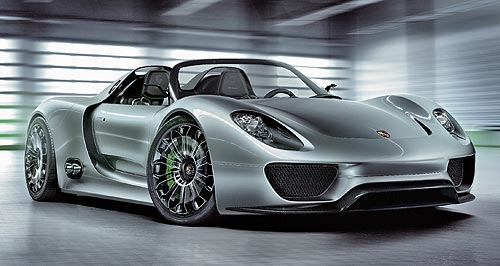News - PorschePorsche electrification planElectric power: A 918 Spyder prototype has already lapped the fearsome Nurburgring faster than any production Porsche. Porsche has joined Toyota and Honda in promising a hybrid in every model25 Oct 2010 GERMAN supercar-maker Porsche has promised to produce hybrid versions of every model in its range. Porsche has already produced two hybrid vehicles – the Cayenne S Hybrid luxury SUV that arrived in Australia in July, and the 911 GT3 Hybrid R racecar revealed earlier this year – and has promised to put the 918 Spyder plug-in hybrid into production within four years. The Stuttgart company may even reintroduce turbocharged four-cylinder engines in its efforts to meet future CO2 emissions requirements. Now firmly under the control of the Volkswagen Group, Porsche looks to have a busy engineering schedule ahead of it because, as well as the promised hybrid vehicles, plans are also in the pipeline for two all-new models. Decisions are expected to made within two months about the new models – a smaller Boxster-style convertible sportscar that could spawn a sub-R8 Audi R4 and a sub-Cayenne SUV based on the Audi Q5, to be called the Cajun.  Left: Porsche 911 GT3 R Hybrid, Porsche Cayenne S Hybrid. Left: Porsche 911 GT3 R Hybrid, Porsche Cayenne S Hybrid.The ‘Baby Boxster’ would use an aluminium chassis developed by Volkswagen, which would also provide access to VW’s BlueMotion hybrid and electric drivetrain technology. Porsche development chief Wolfgang Duerheimer said this month the company was turning to hybrid technology to help reduce its fleet CO2 emissions. “In the future, we will have hybrid drive in every model line,” Mr Duerheimer told Autoweek magazine. The next petrol-electric Porsche model will be the Panamera sedan, which will go on sale next year with the same hybrid drivetrain as its big brother – a parallel hybrid system that combines a 245kW supercharged 3.0-litre petrol V6 with a 34kW electric motor for a maximum output of 279kW and 580Nm. Porsche’s 918 Spyder, a spiritual successor to the V10-engined Carrera GT, will be built in limited numbers in three to four years as a prelude to electrification of the company’s other production sportscars, the 911, Boxster and Cayman. “We want to learn how we can electrify all our sports cars in the future with the help of this short production run,” said Mr Duerheimer of the 918 program. Porsche has been given until 2015 by the European Union to reduce its CO2 emissions to 216 grams per kilometre from its current level of 255g/km, a target that can only be achieved by producing hybrids or smaller engines. “If the CO2 guidelines require it, then our engines will become smaller and may have just four cylinders,” said Mr Duerheimer. “The important thing is that the performance has to be right – the 911 must always be on the cutting edge.” Mr Duerheimer also said Porsche was also looking at turbocharging, direct-injection, four cylinders and weight reduction – including carbon-fibre bodies – to balance the addition of extra safety and comfort features demanded by buyers, resulting in new models that weigh no more than existing ones. “A constant weight is our minimum requirement in the change to a new generation, even with compliance with all the new safety and comfort requirements,” he said. The 918 Spyder prototype gives a taste of what is possible in a hybrid sportscar with its 368kW 3.4-litre V8 engine combined with three electric motors to produce a combined 528kW of power – enough to rocket from 0-100km/h in just 3.2 seconds while still being capable of returning fuel consumption of just 3.0L/100km and Toyota Prius-beating CO2 emissions of only 70g/km. And, judging by reports that the 918 Spyder has lapped the Nurburgring faster than any production Porsche, the all-wheel drive car’s handling and brakes have not been unduly compromised by the weight of electric motors and batteries. By the time it reaches the market in 2014, the 918 Spyder could be even faster, with reports that the petrol engine will be made bigger and more powerful. Porsche’s 911 GT3 R Hybrid racer, which made its debut in this year’s Nurburgring 24 Hour race, employs two 60kW electric motors to drive the front wheels in addition to the regular 360kW flat-six engine driving the rear wheels. The electricity is provided an electrical flywheel system that recharges a battery under brakes. Porsche has said that the 911 must always have a six-cylinder engine and that a hybrid-powered 911 production car was at least four years away from production.  Read more30th of September 2010  Porsche locks in sub-Cayenne SUVRoxster out, Cajun in as Porsche plans an all-new mid-size luxury SUV29th of July 2010  Porsche to produce 918 SpyderPlug-in hybrid supercar confirmed as Porsche plans all-electric sportscar |
Click to sharePorsche articlesResearch Porsche Motor industry news |
















Facebook Twitter Instagram